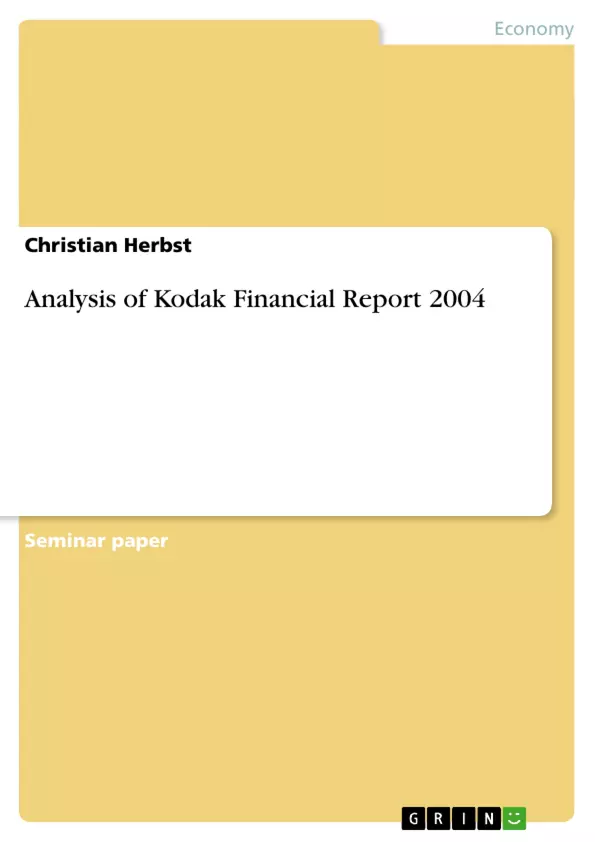The objective of this essay is to evaluate the Kodak financial report 2004 from an investor's point of view. Unlike the management's perspective, which often tries to present the most positive picture possible this analysis is designed to most clearly and critically reflect financial reality, in order to arrive at an estimate of its future potential and value. In deciding whether to buy, hold or sell the company's securities, answers to such questions as follows will be determined in this analysis: - What is the company's record with regard to growth and stability of earnings and cash flow from operations? - How well has the company performed and why? What operating areas have contributed to success and which have not? - What are the company's strengths and weaknesses? How are areas of strengths and weaknesses affecting the company's financial condition and performance? - How risky is the company's financial structure? - How does the company's operating performance compare with its industry competitors? The following chapters will try to concentrate on this questions by dealing with the most important information in a financial report, which is the basic set of financial statements: income statement, balance sheet and statement of cash flows. The statement of shareholder's equity will not be part of this essay, as it is not widely used for analysis and will be shortly covered in the balance sheet chapter. The statements will be discussed and analyzed in detail in the chapters 2-4. In the last chapter, Kodak's background with regard to its firm, industry and economy will be outlined; furthermore, key financial ratios will be calculated and compared to the industrial average. Finally, the investment decision will explained by estimating the future potential and value of the company.
Inhaltsverzeichnis (Table of Contents)
- 1. Introduction
- 2. Statement of earnings
- 3. Balance sheet
- 3.1 Assets
- 3.2 Liabilities
- 3.3 Shareholder's equity
- 4. Statement of Cash Flow
- 4.1 Cash inflows
- 4.2 Cash outflows
- 5. Comprehensive analysis
- 5.1 Background: Firm and industry
- 5.2 Key financial ratios
- 5.3 Segments information
- 5.4 Growth strategy
- 5.5 Summary of analysis
Zielsetzung und Themenschwerpunkte (Objectives and Key Themes)
The main objective of this essay is to evaluate the Kodak financial report of 2004 from an investor's perspective, aiming to critically assess its financial reality and estimate its future potential and value. The analysis will delve into key areas including growth and stability of earnings, operating performance, company strengths and weaknesses, financial structure risk, and comparison with industry competitors.
- Growth and stability of earnings and cash flow from operations
- Performance analysis and identification of contributing factors
- Strengths and weaknesses of the company and their impact on financial condition and performance
- Risk assessment of the company's financial structure
- Comparative analysis of operating performance against industry competitors
Zusammenfassung der Kapitel (Chapter Summaries)
- Chapter 2: Statement of Earnings: This chapter examines Kodak's financial performance in terms of earnings for the years 2004, 2003, and 2002. It analyzes the reported figures, including net sales, cost of goods sold, gross profit, and net earnings, highlighting discrepancies between sales and earnings growth, the impact of accounting principles, and the implications of sales growth exceeding inventory growth.
- Chapter 3: Balance Sheet: This chapter will focus on Kodak's financial position at a specific point in time, examining assets, liabilities, and shareholder's equity. It aims to provide insights into the company's overall financial health, liquidity, and solvency.
- Chapter 4: Statement of Cash Flow: This chapter explores the movement of cash in and out of the company during a specific period. It examines the sources and uses of cash, highlighting key areas of cash flow generation and expenditure.
Schlüsselwörter (Keywords)
This analysis focuses on the financial performance and position of Kodak in 2004. Key terms include: earnings, net sales, cost of goods sold, gross profit, net earnings, financial ratios, financial structure, industry competitors, growth strategy, and investment potential.
- Citar trabajo
- Christian Herbst (Autor), 2005, Analysis of Kodak Financial Report 2004, Múnich, GRIN Verlag, https://www.grin.com/document/39894



